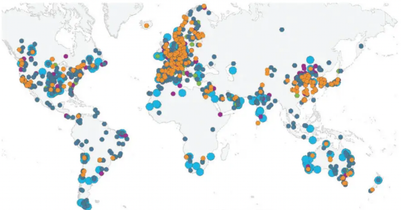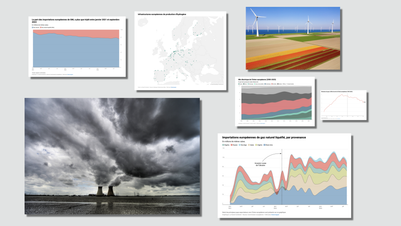article-en
May 2, 2023
Interview: Leading to make a hydrogen-based society
Japan’s Strategic Energy Plan positions hydrogen as integral to the country’s power configuration in 2030, and a large-scale supply chain is needed quickly to achieve carbon neutrality by 2050. Pierre Etienne Franc, the CEO of Hy24, is poised to be a prime driver of carbon-neutral hydrogen projects in the years to come. Read his interview for DBJ corporate magazine.

Interview: Leading to make a hydrogen-based society
Interview of Pierre-Etienne Franc, Chief Executive Officer of Hy24
This piece was originally published in Japanese in Development Bank of Japan (DBJ) corporate magazine in May 2023.
It is important to facilitate cross-sectoral initiatives to expand hydrogen projects. This was the objective behind the establishment of Clean H2 Infra S.L.P., a hydrogen infrastructure fund having Hy24 as its General Partner (GP). As a decarbonized energy source, hydrogen is indispensable to achieving carbon neutrality. Its CO2-free combustion means it will see growing number of applications, particularly in the fields of power generation, transport, and manufacturing. Japan’s Strategic Energy Plan positions hydrogen as integral to the country’s power configuration in 2030, and a large-scale supply chain is needed quickly to achieve carbon neutrality by 2050. At present, hydrogen is costlier than conventional fuels, and it is noted that the cost reduction can be made by building and expanding the global supply chain and developing new technologies. To address these issues, Clean H2 Infra S.L.P. was established, whose GP, Hy24, was launched by two companies: Ardian, which has a proven track record in infrastructure investment, and Five T Hydrogen, which was created by former employees of the hydrogen experts Air Liquide. Pierre Etienne Franc, the CEO of Hy24, is poised to be a prime driver of carbon-neutral hydrogen projects in the years to come. We asked him what he sees as necessary to achieving a hydrogen-powered society.
ESTABLISHING A FRENCH HYDROGEN INFRASTRUCTURE FUND: OBJECTIVES, BACKGROUND, AND STRATEGIES
Tell us about the background to establish the Clean H2 Infra Fund.
The idea for the fund first came to me in June of 2019, in Karuizawa. We were there for the international conference of the Hydrogen Council, which we had established earlier. The venue offered us discussion with major companies and investors with an interest in hydrogen projects, and I brought up the idea of a joint fund composed of industry representatives and financial institutions. In other words, I said it was time to embark on some large-scale projects. That was what led us to launch Clean H2 Infra S.L.P. Later, we created Hy24 to serve as the fund’s GP with a specialist team dedicated to the sector. This comprised FiveT Hydrogen, which I co-founded, after leaving Air Liquide to initiate this fund, and Ardian. In fact, DBJ and I were involved in the establishment of the Japan Hydrogen Station Network LLC (JHyM) for the purpose of full-scale development of hydrogen stations, so we knew each other and had been involved in mobility-related hydrogen infrastructure from that stage. DBJ’s participation was reassuring, and served as the driving force behind this project.
The hydrogen market spans upstream businesses, such as green hydrogen production, and downstream ones, such as hydrogen stations and supply infrastructure. Please tell us what Hy24 is targeting in its strategies.
We are targeting the entire value chain, from production to use. If industrial use of hydrogen is to contribute to decarbonization, this must extend from petroleum refining and chemical generation to steel, cement, mobility and more. We’re thinking of taxis, buses, trucks, ships, and, in the future, aircraft. In the near future, hydrogen will play a part in the energy transition taking place across the world. Renewable energy is fluctuated, so it needs storage options. Hydrogen is also a way to stock it. Ultimately, I am expecting that 15% to 20% of the energy consumption will be in the form of hydrogen or hydrogen rich vectors. Hydrogen’s position will become more important in the future.
Under these circumstances, we believe that Japan and South Korea, which have potential as hydrogen consuming countries, and Australia, which is expected to be competitive in the upstream business, are important investment areas to consider in the Asia-Pacific region.
FEATURES AND TRENDS IN THE GLOBAL HYDROGEN MARKET
How would you describe the hydrogen market Trends ?
The hydrogen market needs to keep an eye on the growing global energy shift. It is acknowledged that there are more than 1,000 hydrogen projects worldwide. Out of these, Europe accounts for one-third of the world’s project investments. North America comes next, followed by the Southern Hemisphere. Asian projects are still small, with an overall investment of about 300 billion euros, but in reality, we believe that about 700 billion euros are needed. We see the situation in Japan as being somewhere between demonstration and pilot project commercialization.
Europe seems to be in the forefront of the transition to hydrogen. What do you think is behind this?
Although Europe seems to be ahead of the curve in terms of energy shift, it is implementing a large part of Japan original vision. Japan has been advocating the importance of shifting from primary energy reliance on oil, coal, and natural gas to hydrogen. In regions that do not have sufficient renewable energy, the choice to use hydrogen to procure renewable energy from other regions becomes important. That is what is now happening globally, especially in Europe. Right now, in Europe, projects are already entering the commercialization phase, with projects realizing several hundred megawatts with large water electrolyzers. In the southern hemisphere countries have also realized the production of hydrogen and its derivative ammonia, and export plans to Japan, South Korea, and Europe have been announced.
The main cause of Europe’s accelerated transition to cleaner energy is the EU’s decision to redirect its policy toward cutting CO2 and greenhouse gas emissions. Large companies were now placed under certain obligations, and transport systems, too, were required to lower their emissions of CO2. As a result, Europe as a whole has started a systemic transition away from carbon. I’d like to see Japan move more rapidly in this direction.
VIEWS ON THE JAPANESE HYDROGEN MARKET
How do you view the Japanese market considering the Japanese government’s hydrogen and ammonia policy/GX policy?
Japan needs to provide ongoing support over several years. It should not be a one-shot deal. We believe that hydrogen is essential for Japan’s future in areas that are difficult to decarbonize by electrification. In order to build a solid mechanism, we believe it is necessary to provide continuous support, not only in terms of regulations and other policies, but also in terms of financial support. In addition, I believe that Japan should not only conduct R&D and demonstrations, but also accelerate commercialization as the next step. It is imperative that public organizations and private companies harmonize to build a competitive production model for hydrogen and other resources in order to lower prices. This will require both government support and stricter regulations to achieve lower prices through regulations that strengthen CO2 emission reductions. We cannot move forward without both regulation and support. Another solution would be expansion of financing mechanism similar to what Air Liquide and DBJ created for JHyM, as mentioned at the beginning of this article.
What are your thoughts on Japan’s hydrogen market, including its challenges?
While Japan may have some small-scale markets, it doesn’t have a carbon market in the true sense of the term. Japan was the first country to work on the formulation of a national hydrogen strategy, but Europe and the United States have taken the lead in scaling up the hydrogen market. In Europe, projects of several tens of megawatts are in progress and will be in the implementation stage in two years. This is partly due to the strong CO2 emissions costs and associated regulations that are pushing European companies to shift to low carbon solutions.
CO2 costs only about 3 euros per ton in Japan(1)(289 JPY per 1 CO2 ton as a Global Warming Tax). Contrast this with the price per ton in Europe, which ranges from 80 to 100 euros. Large companies are faced with substantial penalties if they fail to cut back on CO2, so they have no choice but to act. That’s the situation in Europe. Japan’s next step should be to move quickly toward commercialization and carbon pricing would help. Let’s look at one example. Japan develops and produces hydrogen- and fuel cell-powered vehicles, but in recent years China’s momentum has become more pronounced. China now has about 300 hydrogen stations scattered throughout the country, and its production of hydrogen-powered buses and trucks over the last four years is comparable to the last twenty ears’ production by the entire world. This is a tremendous pace of growth. I think it is time for Japan to find a way to achieve scale. The fundraising mechanism must also be expanded, along with a simultaneous expansion of the market. With moves toward commercialization likely to intensify worldwide, Japan should lose no time in making commercialization a reality.
In terms of cost, public support should be used to increase the volume and supplement the additional cost. Measures to create demand by introducing public support are necessary. Furthermore, regulations need to be strengthened. Currently, there are no regulations with enforceability in place, so there is little incentive for companies and the public to shift to hydrogen and other energy sources. For this reason, we believe that a plan to promote large-scale hydrogen projects has not been fully developed.
On its part, the Japanese government needs to ease some regulations. I earlier expressed the need for stronger regulation of CO2, and now I’m also saying to deregulate. It’s important to raise the competitiveness needed for infrastructure development while easing regulations enough to lower prices. But in Japan today, even the building of a hydrogen station is constrained by extremely strict regulations on matters including safety, usage, and type of accepted piping materials. All of these contribute to hydrogen’s high cost. To create a hydrogen society, the government should push further deregulation. The problem is no longer the technology constraint.
What kind of role would you like your company to play in Japan?
Our objective from the start has been to spread and share risk, aiming for a leverage effect, so that even minority shareholders can take on substantial projects. Even if a balanced budget proves elusive in the early stages, future rates of growth suggest that a growth curve will appear, as in a J-curve, with the balance improving over a certain amount of time. Ultimately, of course, we would like to grow into a rapidly expanding and profitable projects. This is our approach to companies and investors throughout the world, so we hope to develop in the same way in Japan. This is the same approach that we take with companies and investors around the world, and we intend to apply to Japan as well. Currently, Japanese companies can participate in projects in Japan and overseas, and I believe that they can also participate in ammonia and hydrogen export projects. In fact, we have several companies participating in our firm. We are currently working with DBJ on projects and sharing risks, and if public support is provided for these projects, we can expect even greater development. For example, if public support is combined with a 2 billion euro project, it could reach a scale of 20 billion euros. We believe that we can advance a huge hydrogen project for the future.
Please tell us what you would like to see from DBJ in the years to come.
DBJ will play a key role in the building of Japan’s hydrogen infrastructure from the policy making to finance to a very broad customer base. It has provided us with invaluable information on Japan’s energy policy and the movements of Japanese companies. We would like to see this kind of dialogue continue along with DBJ’s long-term support for Japan’s infrastructure development. As a provider of integrated investments and loans, DBJ is, and we hope will continue to be, a unique strategic partner for our firm. We are keen to have DBJ deepen its relationship with our firm, first to pursue this hydrogen project and make it a success, and then to take on further projects with economic and social value in Japan and across the world.
(1) Euro values mentioned in this article are based on the exchange rate of 1 euro/147.72 yen which applied at the time of writing.
Pierre-Etienne Franc has been involved in industrial gas and hydrogen-related businesses at Air Liquide for more than 26 years and has played a key role in the growth of the hydrogen industry, including the creation of the Hydrogen Council in 2017. In 2021, he founded FiveT Hydrogen and became CEO of Hy24, a joint venture between FiveT Hydrogen and Ardian.
DBJ is one of the Clean Hydrogen Infrastructure Fund’s investor. To know more, visit www.dbj.jp

Innovating to finance the hydrogen economy
On the road to a more sustainable economy, we need more investment in sustainable assets. These investments must not only be supported by appropriate regulatory frameworks, but also encouraged and facilitated by financial mechanisms.
More about

Energy Europe – From integration to power
Europe is fragile. It's a fact: it will never have total energy independence. How can we take advantage of this situation? Pierre-Etienne Franc, co-founder and CEO of Hy24, proposes to turn a weakness into a strength - to the benefit of the Union's industrial and foreign policies.
More about

Report: Enabling CO2 standards, a policy toolkit to foster the implementation of AFIR in European Member States
The report was prepared by Hy24 with the contributions of Daimler Truck, Stellantis, Renault, Hyvia, BMW Group, Toyota, Hyundai, Honda, Air Liquide, TotalEnergies, Vinci Concessions, Air Products, Everfuel, Messer, H2Accelerate, Snam, Engie and H2 Mobility to stress the urgency of deploying the HRS network if we are to achieve the ambitious objectives set by AFIR and, more importantly, the decarbonisation targets for the transport sector.
More about
